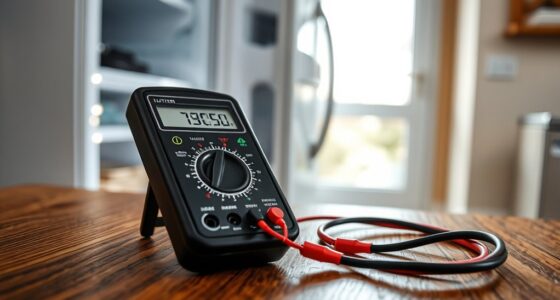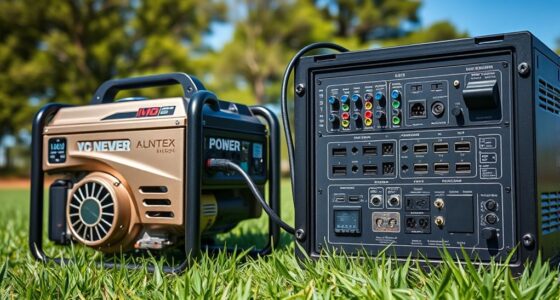To manage fuel supply issues effectively, start by keeping your storage and facility records accurate and audit-ready, addressing any discrepancies promptly. Evaluate your suppliers based on reliability, quality, and performance metrics, and establish clear contracts with penalties for delays or substandard fuel. Regular inspections and fuel testing ensure quality compliance, while robust inventory management prevents shortages. Using technology like monitoring systems and logistics planning helps you stay ahead of disruptions. Continue exploring these strategies to strengthen your fuel supply resilience.
Key Takeaways
- Regularly review and update fuel storage, facility records, and conduct audits to identify discrepancies early.
- Establish clear supplier contracts with KPIs, SLAs, and contingency plans for supply disruptions.
- Ensure fuel quality compliance with ASTM and EPA standards through supplier testing and periodic inspections.
- Maintain detailed inventory records and develop strategies to handle shortages or delays proactively.
- Utilize technology for real-time monitoring, online ordering, and data integration to enhance supply chain transparency.
Comprehensive Fuel Supply Management Checklist

Ensuring a reliable fuel supply is essential for maintaining your operations smoothly. To do that, you need a comprehensive fuel supply issues checklist that addresses every critical aspect of fuel management. First, regularly reviewing your fuel storage and facility records is vital. Keeping these records up-to-date and audit-ready helps you identify discrepancies early and stay compliant with regulations. Conducting a fuel self-audit at least once a year is necessary, but performing more frequent checks, especially in the second quarter, can catch issues before they escalate. Remember, clear responsibility must be assigned to your highest-ranking local managers or contractors for conducting station audits and ensuring compliance. Any audit findings should be addressed swiftly, with corrective actions completed within 30 days. If you switch vendors, a mandatory self-audit within three months ensures continued compliance and operational continuity.
Next, evaluate your fuel suppliers carefully. Reliability and reputation matter; you want suppliers who can deliver consistently without delays. Your contracts should clearly specify pricing structures, transparency, and penalties for late or substandard deliveries. Establishing risk management plans for potential supply disruptions is equally important. These plans should include contingency procedures for emergencies, such as alternative suppliers or stockpiling strategies. Confirm your agreements with key suppliers to align expectations and responsibilities. Setting up Key Performance Indicators (KPIs) and Service Level Agreements (SLAs) allows you to monitor supplier performance proactively and address issues promptly.
Fuel quality is another crucial area. You must ensure that the fuel you receive meets industry standards like ASTM and EPA regulations to prevent equipment damage and environmental violations. Require your suppliers to provide regular fuel testing results and quality assurance measures. Monitoring additives and sulfur content helps optimize engine performance and compliance with environmental standards. Conduct periodic inspections during storage and delivery to catch contamination or substandard fuel early. Include contractual clauses that specify corrective actions and timelines if substandard fuel is detected.
Managing your inventory effectively is key to avoiding stock-outs or overstocking. Keep detailed records of fuel quantities and related consumables to maintain balance. Identify critical components that impact your operations and develop mitigation strategies for potential shortages or delays. Coordinating logistics and staffing ensures your supply chain remains resilient, especially during emergencies or disasters. Incorporating water management practices and ensuring proper storage conditions can help prevent fuel contamination and degradation.
Finally, leverage technology to streamline your fuel management. Use digital platforms for online ordering, electronic billing, and real-time tracking of deliveries. Employ fuel tank monitoring systems for accurate consumption data and better inventory forecasting. Fully integrate these systems with your fleet and inventory management tools to improve data accuracy and operational insights. Utilize analytics and reporting features to optimize fuel usage and control costs. With these steps, your fuel supply remains resilient, consistent, and compliant, supporting uninterrupted operations at all times.
Frequently Asked Questions
How Often Should Fuel Supply Systems Be Inspected?
You should inspect fuel supply systems at least annually, but weekly inspections are necessary for emergency generators, especially in healthcare facilities. Regularly check for leaks, damage, and proper signage, and make certain fuel levels and pressure are adequate. Follow manufacturer recommendations and NFPA standards for maintenance intervals, and document all inspections thoroughly. Consistent inspection ensures safety, compliance, and reliable operation during emergencies.
What Are the Common Signs of Fuel Contamination?
You’ll notice fuel contamination through dark, cloudy fuel, debris floating in the tank, or sludge buildup. Unusual odors like rotten eggs indicate sulfur bacteria. Engine performance issues such as sputtering, rough idling, or difficulty starting often point to contaminated fuel. Increased exhaust smoke and engine stalling also signal contamination. Regularly check for these signs to catch problems early and avoid costly repairs caused by polluted fuel.
Which Safety Precautions Are Essential During Fuel Handling?
During fuel handling, you must follow essential safety precautions to prevent accidents and health hazards. Always wear chemical-resistant gloves, flame-resistant clothing, safety goggles, and non-slip footwear. Keep ignition sources away, ground and bond equipment, and fill containers on the ground to avoid static sparks. Regularly inspect equipment for damage, keep fire extinguishers accessible, and clean spills immediately. These steps guarantee safe, responsible handling and minimize risks of fire, leaks, or exposure.
How Can I Prevent Fuel Theft or Misappropriation?
You can lock down fuel access by installing tamper-resistant caps and anti-siphoning devices, making it tough for thieves to strike. Use GPS and sensors to keep an eye on fuel levels and spot discrepancies early. Secure parking in well-lit, closely packed areas, and restrict access to authorized personnel only. Regular audits and collaborating with law enforcement serve as added layers of protection—covering all bases to keep fuel theft at bay.
What Are the Environmental Regulations Affecting Fuel Storage?
You need to follow environmental regulations like UST and AST rules to prevent contamination. Guarantee underground tanks meet EPA standards for leak prevention, inspections, and proper registration. For aboveground tanks, comply with spill prevention, secondary containment, and corrosion protection requirements. Regularly install and test leak detection systems, maintain spill response plans, and adhere to federal laws like the Clean Water Act. Staying compliant helps protect groundwater and soil while avoiding penalties.
Conclusion
Stay vigilant with your fuel supply management. By following this checklist, you’ve minimized risks and prepared for unexpected disruptions. But remember, even the best plans can face unforeseen challenges. Are you truly ready for what’s around the corner? Keep monitoring, stay flexible, and keep your eyes open—because when the unexpected hits, it’s those who anticipate who’ll come out ahead. Don’t let your guard down; the next surprise could be just around the bend.










